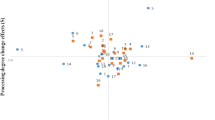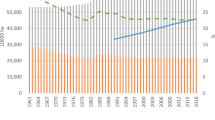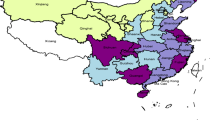Abstract
Research on effects of ecological restoration and afforestation and their links to land conservation and regional development have received global attention. The Chinese government has successively invested a substantial amount of funds in the Grain for Green Program (GGP) since the mid-1990s. The economic effects of the GGP on macroeconomic growth could be attributed to an increase in agricultural production and off-farm employment and follow-up industry development. Few studies have focused on economic effects of the GGP at the national level using long-term series of panel data in 31 provinces and cities across the country. This study analyzed the regional differentiation and temporal-spatial changes in the GGP and investigated economic impacts of the GGP at different scales. Results showed that the scale of the GGP varied significantly in the eastern, central and western regions and regional changes were characterized by temporal differentiation from 2000 to 2016. The GGP had a slightly negative impact on China’s economic growth, which presented an overall U-shape, changed with an increase in economic growth. Significant regional heterogeneities in economic growth and impacts of the GGP were observed in the eastern, central and western regions. In the current situation in China, the technical progress, adjustment of industrial structure and focus on human capital to promote the development of follow-up industries and farmers’ labor skills have demonstrated the role for improving economic growth and optimizing the GGP arrangement. It is crucial to achieve a synergy between ecosystem conservation and regional economic in China.




Similar content being viewed by others
References
Agovino, M., Ferrara, M., & Garofalo, A. (2018). Investigating the driving factors of the landfill disposal rate: A quantile regression for Italian data. Environment, Development and Sustainability, 3, 1–18.
Aldieri, L., Carlucci, F., Vinci, C. P., & Yigitcanlar, T. (2019a). Environmental innovation, knowledge spillovers and policy implications: A systematic review of the economic effects literature. Journal of Cleaner Production, 239, 118051.
Aldieri, L., Grafström, J., Sundström, K., & Vinci, C. P. (2019b). Wind power and job creation. Sustainability, 12(1), 45.
Aldieri, L., Kotsemir, M., & Paolo Vinci, C. (2019c). Environmental innovations and productivity: Empirical evidence from Russian regions. Resources Policy, 101444.
Ali, G. (2018). Climate change and associated spatial heterogeneity of Pakistan: Empirical evidence using multidisciplinary approach. Science of the Total Environment, 634, 95–108.
Ali, G., Ashraf, A., Bashir, M. K., & Cui, S. (2017). Exploring environmental Kuznets curve (EKC) in relation to green revolution: A case study of Pakistan. Environmental Science & Policy, 77, 166–171.
Ansuategi, A., & Marsiglio, S. (2017). Is environmental protection beneficial for the environment? Review of Development Economics, 21(3), 786–802.
Bassett, G., & Koenker, R. (1978). Regression quantiles. Econometrica, 46(1), 33–50.
Bryan, B. A., Gao, L., Ye, Y., Sun, X., Connor, J. D., Crossman, N. D., et al. (2018). China’s response to a national land-system sustainability emergency. Nature, 559(7713), 193–204.
Canay, I. A. (2011). A simple approach to quantile regression for panel data. The Econometrics Journal, 14(3), 368–386.
Cao, S., Xu, C., Chen, L., & Wang, X. (2009). Attitudes of farmers in China’s northern Shaanxi Province towards the land-use changes required under the Grain for Green Project, and implications for the project’s success. Land Use Policy, 26(4), 1182–1194.
Chen, W., & Lei, Y. (2018). The impacts of renewable energy and technological innovation on environment-energy-growth nexus: New evidence from a panel quantile regression. Renewable Energy, 123, 1–14.
Chen, L., & Long, K. (2007). Econometric analysis of relationship between cultivated land quantity and economic development. China Land Science, 4, 6–12. (in Chinese).
Chen, K., Yang, X., & Xu, J. (2007). The analyses of sloping land conversion program’ economic sustainability and follow-up policy research. Problems of Forestry Economics, 02, 8–12. (in Chinese).
China State Statistical Bureau (CSSB) (2001–2017). China’s statistics for years 2000–2016. China Beijing: State Statistical Press (in Chinese press).
Du, G., Sun, X., Liu, Y., Zheng, H., & Ma, R. (2017). Temporal and spatial-differentiation characteristics of ecological restoration in loess plateau. Journal of Geo-Information Science, 19(3), 355–364. (in Chinese).
Feng, L., Wei, L., & Jiang, Y. (2008). Study on the contribution of land element to economic growth in China. China Land Science, 22(12), 4–10.
Goldsmith, R. W. (1951). A perpetual inventory of national wealth. In Studies in income and wealth, Volume 14 (pp. 5–73). NBER.
Huang, L., Shao, Q., & Liu, J. (2012). Forest restoration to achieve both ecological and economic progress, Poyang Lake basin, China. Ecological Engineering, 44, 53–60.
Kaika, D., & Zervas, E. (2013). The environmental Kuznets curve (EKC) theory—Part A: Concept, causes and the CO2 emissions case. Energy Policy, 62, 1392–1402.
Kelly, P., & Huo, X. (2013). Do farmers or governments make better land conservation choices? Evidence from China’s Sloping Land Conversion Program. Journal of Forest Economics, 19(1), 32–60.
Koenker, R. (2004). Quantile regression for longitudinal data. Journal of Multivariate Analysis, 91(1), 74–89.
Lancaster, T. (2000). The incidental parameter problem since 1948. Journal of econometrics, 95(2), 391–413.
Li, Q., Amjath Babu, T., Sieber, S., & Zander, P. (2018). Assessing divergent consequences of payments for ecosystem services on rural livelihoods: A case-study in China’s Loess Hills. Land Degradation and Development, 29(10), 3549–3570.
Li, G., & Shi, H. (2017). The relationship between GTGP and regional economic growth based on Ramsey–Cass–Koopmans modeling. Resources Science, 39(9), 1712–1724. (in Chinese).
Li, D., & Xia, E. (2013). Research on the influence of human capital on China economy growth based on extended Solow model. China Population, Resources and Environment, 23(8), 100–106. (in Chinese).
Li, H., Yao, S., Yin, R., & Liu, G. (2015). Assessing the decadal impact of China’s sloping land conversion program on household income under enrollment and earning differentiation. Forest Policy and Economics, 61, 95–103.
Liu, Y. (2018). The studies that the problem of rural landless peasants after returning farnland to lake, taking guanglong aommunity of chengjiang county as an example. Yunnan: Yunnan University of Finance and Economics. (in Chinese).
Liu, J., Li, S., Ouyang, Z., Tam, C., & Chen, X. (2008). Ecological and socioeconomic effects of China’s policies for ecosystem services. Proceedings of the National Academy of Sciences, 105(28), 9477–9482.
Neycheva, M. (2013). Does higher level of education of the labor force cause growth? Evidence from Bulgaria. Economic Change and Restructuring, 46(3), 321–339.
Peng, H., Cheng, G., Xu, Z., Yin, Y., & Xu, W. (2007). Social, economic, and ecological impacts of the “Grain for Green” project in China: A preliminary case in Zhangye, Northwest China. Journal of Environmental Management, 85(3), 774–784.
Persson, M., Moberg, J., Ostwald, M., & Xu, J. (2013). The Chinese Grain for Green Programme: Assessing the carbon sequestered via land reform. Journal of Environmental Management, 126, 142–146.
Romer, D. (2006). Advanced macroeconomics (3rd ed.). New York: McGraw-Hill/Irwin.
Sepehrdoust, H., & Zamani, S. (2017). The challenge of economic growth and environmental protection in developing economies. Iranian Economic Review, 21(4), 865–883.
Sinha Babu, S., & Datta, S. K. (2014). Revisiting the link between socio-economic development and environmental status indicators—focus on panel data. Environment, Development and Sustainability, 17(3), 567–586.
Teixeira, A. A., & Queirós, A. S. (2016). Economic growth, human capital and structural change: A dynamic panel data analysis. Research Policy, 45(8), 1636–1648.
Wang, Q. (2019). In the past 20 years, China has returned cultivated land to forests and grassland for 500 million mu. Land Greening, (7), 5–6. (in Chinese).
Wang, J., Chen, Y., Shao, X., Zhang, Y., & Cao, Y. (2012a). Land-use changes and policy dimension driving forces in China: Present, trend and future. Land Use Policy, 29(4), 737–749.
Wang, S., & Deng, Z. L. (2016). Research on the economic effects of the grain for green project. Journal of Central University of Finance & Economics, 345(05), 11–18.
Wang, J. K., & Gu, G. F. (2015). Study on contribution of land element to urban economic growth in China. China Population, Resources and Environment, 25(8), 11–17.
Wang, J., Lin, Y. F., Glendinning, A., & Xu, Y. Q. (2018). Land-use changes and land policies evolution in China’s urbanization processes. Land Use Policy, 75, 375–387.
Wang, S., & Yue, X. (2017). The Grain-for-Green Project, non-farm employment, and the growth of farmer income. Economic Research Journal, 52(04), 106–119. (in Chinese).
Wang, Q., Zhao, Z., Shen, N., & Liu, T. (2015). Have Chinese cities achieved the win–win between environmental protection and economic development? From the perspective of environmental efficiency. Ecological Indicators, 51, 151–158.
Wang, J., Zheng, Z., Shao, X., Chen, B., Huang, X., & Zhang, Y. (2012b). China land use change and sustainable development. Beijing: Chinese Financial & Economic Publishing House. (in Chinese).
Xie, X., Ma, X., & Zhang, S. (2011). Evaluating income impacts of slopping land conversion program in china: A matching did model. Acta Scientiarum Naturalium Universitatis Pekinensis, 47(4), 759–767.
Xie, X., Zhang, S., & Zhu, S. (2010). Impacts of sloping land conversion program on households’ sustainable livelihood. Acta Scientiarum Naturalium Universitatis Pekinensis, 46(3), 457–464.
Xiong, Y., Wang, K., Lan, W., & Qi, H. (2004). Evaluation of the lake recovery area eco-compensation in Dongting Lake Wetland. Acta Geographica Sinica, 59(5), 780–789. (in Chinese).
Xu, J., Wang, Q., & Kong, M. (2018). Livelihood changes matter for the sustainability of ecological restoration: A case analysis of the Grain for Green Program in China’s largest Giant Panda Reserve. Ecology and evolution, 8(8), 3842–3850.
Xu, J., Yin, R., Li, Z., & Liu, C. (2006). China’s ecological rehabilitation: Unprecedented efforts, dramatic impacts, and requisite policies. Ecological Economics, 57(4), 595–607.
Zhang, C. (2018). Factors affecting risk perception of farmers in the new round returning cultivated land to forest project in the Ak-su Region. Resources Science, 40(07), 1387–1396. (in Chinese).
Zhang, K., Dang, H., Tan, S., Cheng, X., & Zhang, Q. (2010). Change in soil organic carbon following the ‘Grain-for-Green’ programme in China. Land Degradation and Development, 21(1), 13–23.
Zhang, B., He, C. H., Burnham, M., & Zhang, L. (2016). Evaluating the coupling effects of climate aridity and vegetation restoration on soil erosion over the Loess Plateau in China. Science of the Total Environment, 539, 436–449.
Zhang, Q., Song, C., & Chen, X. (2018). Effects of China’s payment for ecosystem services programs on cropland abandonment: A case study in Tiantangzhai Township, Anhui, China. Land Use Policy, 73, 239–248.
Zhou, Z. (2010). Achieving food security in China: Past three decades and beyond. China Agricultural Economic Review, 2(3), 251–275.
Zhu, H., Duan, L., Guo, Y., & Yu, K. (2016). The effects of FDI, economic growth and energy consumption on carbon emissions in ASEAN-5: Evidence from panel quantile regression. Economic Modelling, 58, 237–248.
Zhu, H., Yang, G., & Han, L. (2014). Changes of economic and rural industrial structure since the implementation of Grain for Green in Ansai County. In 2014 7th International Joint Conference on Computational Sciences and Optimization, 2014 (pp. 680–683): IEEE
Acknowledgements
The authors acknowledge financial support from the National Natural Science Foundation of China (41 871 203).
Author information
Authors and Affiliations
Corresponding author
Additional information
Publisher's Note
Springer Nature remains neutral with regard to jurisdictional claims in published maps and institutional affiliations.
Rights and permissions
About this article
Cite this article
Liu, J., Wang, J., Li, Z. et al. Exploring impacts of the Grain for Green program on Chinese economic growth. Environ Dev Sustain 23, 5215–5232 (2021). https://doi.org/10.1007/s10668-020-00810-1
Received:
Accepted:
Published:
Issue Date:
DOI: https://doi.org/10.1007/s10668-020-00810-1




